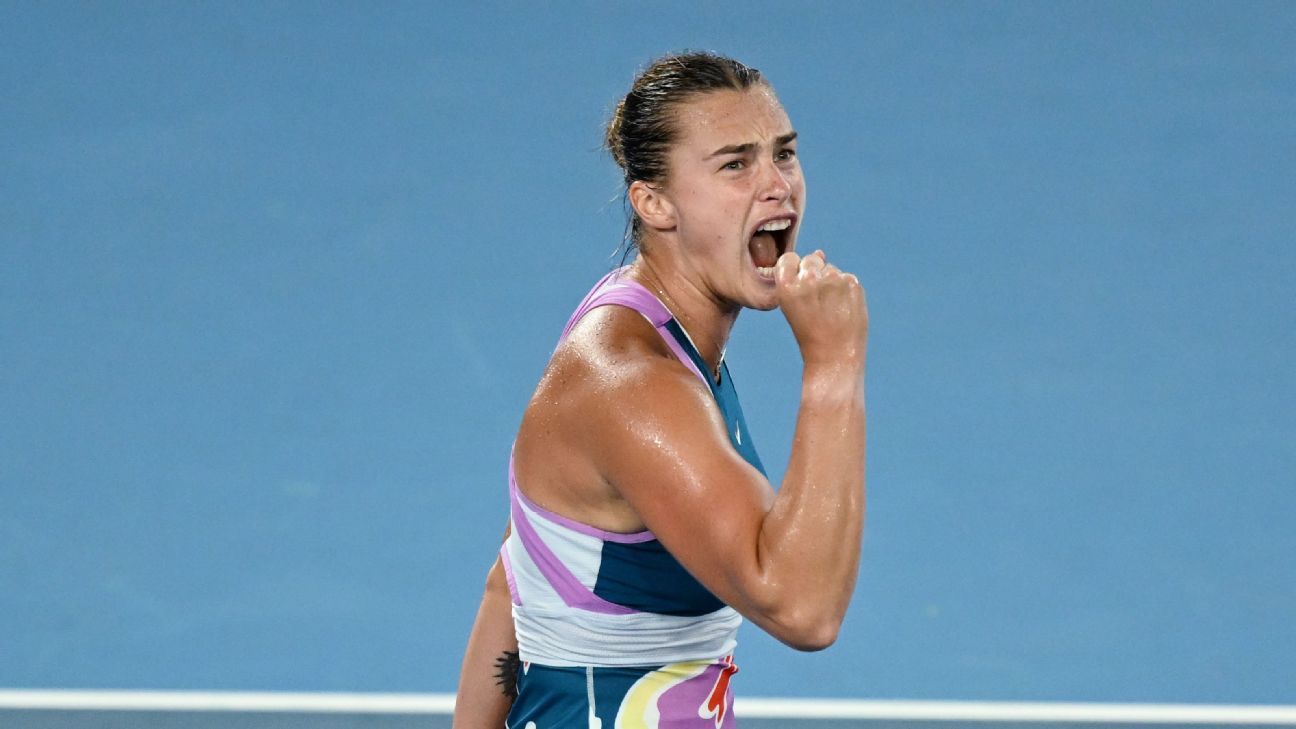Products You May Like
MELBOURNE, Australia — Sheer aggression and a high-risk, high-reward philosophy helped Aryna Sabalenka clinch an epic Australian Open final over Elena Rybakina.
The Belarusian battered and bruised her way to the title at Melbourne Park, coming from a set down to overwhelm last year’s Wimbledon champion 4-6, 6-3, 6-4.
“We’ve been through a lot of downs last year. We worked so hard, you guys deserve this trophy, it’s more about you than about me,” Sabalenka said to her players’ box after receiving the Daphne Akhurst Memorial Cup from Billie Jean King. “I’m still shaking and super nervous. Thank you so much for everything you do for me. I love you.”
It’s the first major triumph for Sabalenka, who, prior to this fortnight, had reached the semifinal stage of a Slam on three occasions.
How did Sabalenka win on Saturday evening and what does it mean for her going forward? Here are our key takeaways.
How the match was won
The Rybakina serve is on a shortlist for the greatest weapon in the women’s game. Entering the final, she led the tournament in aces and had clocked the fastest serve speed of the fortnight at 195km/h (121.2mp/h). No player in the women’s draw was winning a higher percentage of points than Rybakina when her first serve landed in play (80%) and she was the only player in the women’s draw who benefitted from having over 50% of her first serves unreturned — a mark of her power, precision and consistency.
For Sabalenka to win the title, she had to find a way to neutralize Rybakina’s greatest asset. Early on, she had few answers as Rybakina raised her tournament first-serve percentage from 55% to 65% en route to taking the first set 6-4.
But as Rybakina began missing her mark as the match wore on, and that figure began to plummet, Sabalenka was able to eye off more second serves and let her aggressive game style overwhelm. She struck winners from behind the baseline and kept the errors low, all the while piling the pressure on Rybakina.
In the end, it was Sabalenka’s serve which began yielding greater results. She finished the final with 17 aces, landed her first serve 65% of the time — also up 5% from her tournament average — and used it effectively to set up points.
It’s all mental for Sabalenka
One year ago, Sabalenka fought back tears as she attempted to explain her shocking fourth-round Australian Open loss to the unseeded Kaia Kanepi, a match in which she had committed 40 unforced errors and an inexplicable 15 double faults.
“I started well, but then I lost focus and, yeah, then it became really emotional and I couldn’t find a way back,” Sabalenka admitted after the loss.
Tonight, a murmur echoed around Rod Laver Arena when Sabalenka conceded the first point of the final with a double fault. But she responded with an ace on the very next point.
Sabalenka’s first set featured five double faults, something which is still a clear Achilles heel to her otherwise flawless game. Last season, she committed 428 double faults, at an average of 7.78 per match. She won just 41.8% of her second-serve points and lost 33% of her service games — the worst ratio of any woman ranked in the top 25 at season’s end.
But in the final two sets, Sabalenka made only two double faults. She also tidied up the unforced errors — finishing with just 28 for the match, her lowest rate per-point for any match at the tournament.
Power meets power
Both Sabalenka and Rybakina lived up to the billing as two of the heaviest hitters on the women’s tour. The final began as a serving clinic, with the pair combining for seven aces through three games. It was a trend which would continue into the night, with 26 aces by the time Sabalenka was crowned champion.
Both finalists exhibited tremendous baseline power. Sabalenka hammered 51 winners, while Rybakina had 31 of her own.
The aggression and fearless approach has been a hallmark of Sabalenka’s tournament. This fortnight, she has struck a higher percentage of winners (28%) than anyone else. A staggering 49% of her points have ended with either a Sabalenka winner or unforced error. For context, Rybakina comes in at 42%, and Coco Gauff at 34%.
Stat of the match
Sabalenka’s come-from-behind win over Rybakina was the seventh time since the beginning of 2020 that she had dropped the first set and gone on to win a match at a Grand Slam. According to ESPN Stats & Information, no player on the women’s tour has more such wins in that span.
What it means
When the next edition of the WTA rankings are released on Monday, Sabalenka will have climbed three places to world No. 2, trailing only Poland’s Iga Swiatek for top billing. It’s a just ranking. Over the past 18 months, Sabalenka has reached at least the semifinal stage at four Slams, including her victory Saturday.
Clay isn’t Sabalenka’s preferred surface but with the form she’s shown in Australia to launch the year — winning 20 of 21 sets and back-to-back titles — she’ll again be amongst the favorites for the French Open title in May.
For Rybakina, her run to the final will see her climb to 10th. Had the WTA not stripped Wimbledon of its ranking points last year, due to the ban on Russian and Belarusian players, Rybakina would be looking at the No. 3 spot in the rankings.
